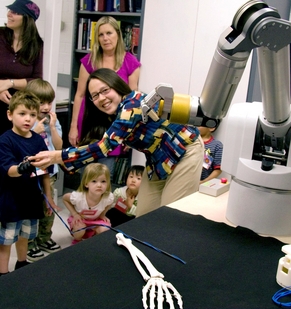
Helping hands: A human-machine solution
Posted: July 21, 2010

ASU mechanical engineer Veronica Santos shows pre-school students how to operate a robot hand in her Biomechtronics Lab.
Promising robotics technology research earns an ASU mechanical engineer support through a prestigious National Science Foundation Career Award
A human hand is quite simply the most agile, able and responsive manipulation tool in existence. If its combination of grasping, sensing and reaction capabilities could be fully replicated through technology, the impact would be potentially momentous.
Beyond significant benefits for people in need of artificial limbs or wheelchairs, the technology might be adapted for surgery and other medical and physical rehabilitation uses, for space and deep-sea exploration, or for military and emergency rescue operations in harsh or unsafe environments.
The promise of such advances drives the research aspirations of Veronica J. Santos, an assistant professor in the School for Engineering of Matter, Transport and Energy, one of ASU’s Ira A. Fulton Schools of Engineering.
“If we can learn from nature’s solution to our need to grasp and manipulate objects, and use that to maximize the performance of robotic hands, we will have met one of the grand challenges of modern engineering,” Santos said.
She now will have the opportunity to expand ASU’s research in robotics. Santos recently won a prestigious National Science Foundation Career Award, which recognizes scientists and engineers in the early stages of their careers who show potential to be leaders and innovators in their fields of expertise.
The award will provide her research team more than $550,000 over five years to improve robotic manipulation capabilities and educate students about the latest robotic technologies.
Today’s robotic tools are good at performing precise and repetitive functions in a controlled environment. Santos and her team will strive to find keys to a robotics evolution that will enable the machines to perform reliably in uncertain conditions and when encountering unfamiliar objects.
The research will involve meshing skills in biological, mechanical and electrical engineering to gain deeper knowledge of the movement capabilities of the human body, and find ways to make technology perform similarly.
It will require more understanding of the intricate working of the hand, and how to analyze and measure its abilities. Santos and her team will seek more in-depth knowledge of muscle biomechanics and the signaling patterns between the brain, the spinal cord and the hand that enable humans to act rapidly and adeptly.
Advances in delicate sensory technology will be needed to make such robotic systems work – including development of a flexible electronic “skin” that can sense force and vibration.
Santos will get help from bioengineering professor Marco Santello, an expert in kinesiology (the study of motion), and Jonathan Posner, an assistant professor of mechanical and chemical engineering.
Santello will provide expertise on electromyographic techniques for listening to muscles in motion and recording the timing of muscle activity. Posner will provide expertise on soft lithography techniques for developing a flexible electronic skin for artificial hands.
It’s all aimed at developing a robot hand that will not only simulate the performance of human hands – with their 2,000 tactile sensors in each fingertip – but also demonstrate dexterity within the framework of the sense-think-act loop through which humans control their actions, Santos explained.
That achievement would be the basis for development of a clinically viable neuroprosthetic robot hand, and an equally versatile robot hand for wheelchair-mounted robot arms.
Of course, each device will need to be durable, compact, lightweight, compatible with human anatomy, and be capable of reacting adroitly in unpredictable environments, using computer programs based on simple instructions, Santos said.
In addition to giving several ASU mechanical engineering graduate students opportunities to work with her research team, Santos will use the grant to support a number of education outreach projects.
Her team will develop low-cost, hands-on instruction to introduce elementary school students to engineering through robotics studies.
Her team will also construct an interactive robotics exhibit for science center and museum exhibits geared for elementary and middle school students.
In addition, Santos’s research advances will be employed to expand a graduate-level course in robotics and adapt the class material for an undergraduate course.
Santos earned a degree in mechanical engineering with a minor in music from the University of California at Berkeley, and master’s and doctoral degrees in mechanical engineering with a biometry minor from Cornell University in New York.
She did postdoctoral research at the Alfred E. Mann Institute for Biomedical Engineering at the University of Southern California where she worked on a team to develop a novel biomimetic tactile sensor for prosthetic hands.
She was a quality engineer, and a research and development engineer, at Guidant Corporation in California, specializing in cardiovascular technology.
Santos has won the Young Investigator Poster Presentation Award from the International Society of Biomechanics, an Exceptional Teaching Assistant Award from the Sibley School of Mechanical and Aerospace Engineering at Cornell University and a National Science Foundation Graduate Research Fellowship.



































